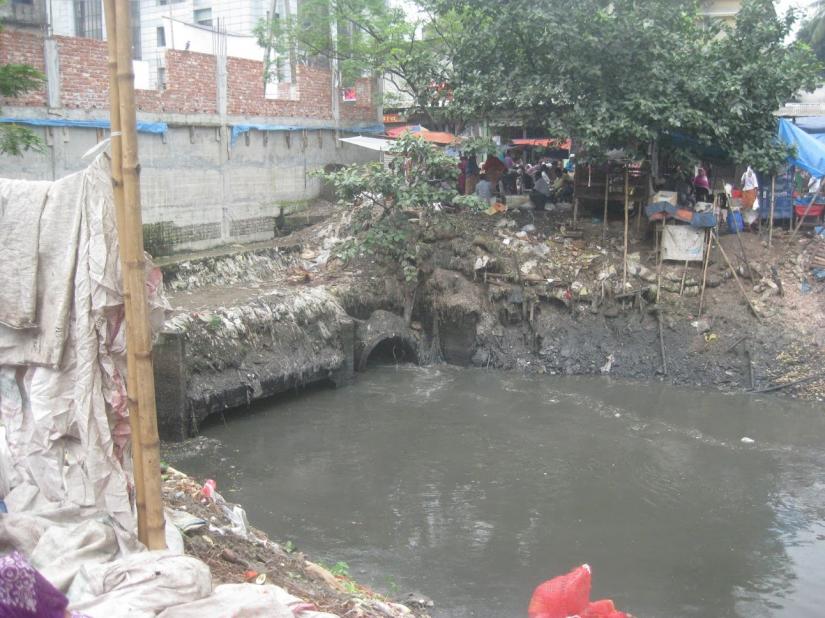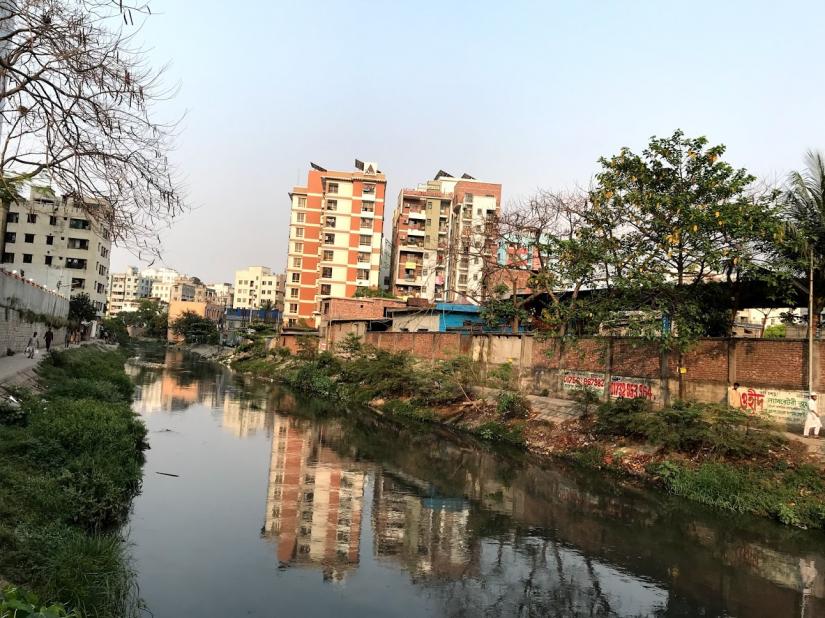 Dhaka, the capital of present day Bangladesh, is an almost 400 years old city, and has also been the ancient capital of Mughal Province of the then Bengal intermittently. It has seen many ups and downs in its fortune since it was captured by Mughals from Pathan rulers. As the capital of a frontier province, it was always strategically significant. Morphing from a military outpost to a flourishing production and trade center quite rapidly. It sits almost on the confluence of the tributaries of two large river basins, namely the Meghna and the Brahmaputra. The rivers Buriganga, Shitalakkhya, Turag and Balu continue to flow though in a miserable condition around its periphery. Also, Dhaka used to have two large canals, which sometimes have been termed as rivers — Dholai and Pandu.
Dhaka, the capital of present day Bangladesh, is an almost 400 years old city, and has also been the ancient capital of Mughal Province of the then Bengal intermittently. It has seen many ups and downs in its fortune since it was captured by Mughals from Pathan rulers. As the capital of a frontier province, it was always strategically significant. Morphing from a military outpost to a flourishing production and trade center quite rapidly. It sits almost on the confluence of the tributaries of two large river basins, namely the Meghna and the Brahmaputra. The rivers Buriganga, Shitalakkhya, Turag and Balu continue to flow though in a miserable condition around its periphery. Also, Dhaka used to have two large canals, which sometimes have been termed as rivers — Dholai and Pandu.
Historical Importance
When the Mughals tried to establish their stronghold in this part of Bengal, the worst enemy they faced were the calamitous nature, riverine landscape, and the indomitable ‘Baro Bhuiyans’. Another fear was the raids by the Magh (Arakanese) and Portuguese (also Dutch) pirates coming from the Bay of Bengal through large rivers (Meghna and Brahmaputra). The horse ridden Mughals understood that to dominate politically in Bengal they had to secure the waterways first. As a result, they invested heavily in developing a river fortification system in Bengal centering in Dhaka to protect their empire, especially from raids by Maghs and others and also to expand their territory while using the forts as base camps for their future campaigns. They built river forts at Shonakanda and Haziganj (both now in Narayanganj), Idrakpur (now in Munshiganj), Dhapa and Fatullah forts (now lost) and used the old Pusht-e-Killa (now Postogola, near Mill Barrack area) at the mouth of Dholai Canal.
As a result, they invested heavily in developing a river fortification system in Bengal centering in Dhaka to protect their empire, especially from raids by Maghs and others and also to expand their territory while using the forts as base camps for their future campaigns. They built river forts at Shonakanda and Haziganj (both now in Narayanganj), Idrakpur (now in Munshiganj), Dhapa and Fatullah forts (now lost) and used the old Pusht-e-Killa (now Postogola, near Mill Barrack area) at the mouth of Dholai Canal.
There were also forts in other areas like Egarosindur, Daudkandi, etc. in the region by the side of a river or in strategic positions; most of these have been destroyed and in ruins now. Dhaka, the capital of Bengal ‘Subah’, acted like a base camp to launch the expedition and invasionS of other kingdoms nearby for further expansion of Mughal empire.
Waterways as a mode of transport
From the early days of the city, waterways and boats played an important role in its transport system, moving both passengers and goods. But the city also had swamps or marshes covering a substantial area, which made large vessel movement quite difficult and resulted in low accessibility, especially in the dry season. Walking, ox driven carts etc. were the other options for movement for commoners, while the well-offs rode palanquins, horses or elephants. It has been said that, there were no metalled roads before Mughal occupation, which probably is not true.  It is well known that, one road (Tongi-Dhaka-Narayanganj) was there already before the Mughal conquests, as a connection to the Grand Trunk Road (which was built by Sher Shah). But along with the roads, Mughals also built flood protection structure (bund) to save the city from frequent inundation. They dug up and extended the Dholai Canal to ensure easier movement of their naval fleet (Nowara). It can be said that, the transport system remained almost the same; consisting mainly of walking, animal driven carts, palanquins and various kinds of boats for around 200 years (since the 1600s), though a few roads and bridges were made (predominantly for movement of the troops or navy for defense purposes).
It is well known that, one road (Tongi-Dhaka-Narayanganj) was there already before the Mughal conquests, as a connection to the Grand Trunk Road (which was built by Sher Shah). But along with the roads, Mughals also built flood protection structure (bund) to save the city from frequent inundation. They dug up and extended the Dholai Canal to ensure easier movement of their naval fleet (Nowara). It can be said that, the transport system remained almost the same; consisting mainly of walking, animal driven carts, palanquins and various kinds of boats for around 200 years (since the 1600s), though a few roads and bridges were made (predominantly for movement of the troops or navy for defense purposes).
Losing the waterbodies
After the arrival of the Europeans, especially the British and the handover of the administrative and political power to them; the transport system started to change radically, mainly due to business rationale. Horse-driven carriages were introduced as public transport, a first of its kind in Dhaka in 1856, although they were used as a private transport, probably since 1790's. The first train came to the city in 1885, which connected the very important river port of Narayanganj and in the next phase connected a jute production center, Mymensingh. This reduced the reliance on water transport for goods to next to nothing. On the other hand, cars started to come to Dhaka city from the 1910s, buses and taxis were introduced in the 1920s and 1930s respectively. After the First World War, trucks and make-shift buses for the troops which were left behind, served as buses in 1920s. Another very important mode of transport, rickshaws were introduced in mid-1930s. So the movement of goods and people by water transport gradually shifted towards surface based transport systems, like rail and road for better reliability and speed. Previously, supplies for the city markets generally were catered by water transport through the canals. Also, the city corporation, which was established in 1864, started to build and maintain roads, and managed drainage and sewerage systems which shifted focus from maintaining the waterbodies for utility.
On the other hand, cars started to come to Dhaka city from the 1910s, buses and taxis were introduced in the 1920s and 1930s respectively. After the First World War, trucks and make-shift buses for the troops which were left behind, served as buses in 1920s. Another very important mode of transport, rickshaws were introduced in mid-1930s. So the movement of goods and people by water transport gradually shifted towards surface based transport systems, like rail and road for better reliability and speed. Previously, supplies for the city markets generally were catered by water transport through the canals. Also, the city corporation, which was established in 1864, started to build and maintain roads, and managed drainage and sewerage systems which shifted focus from maintaining the waterbodies for utility.
All these changes resulted in less and less importance of the waterbodies in Dhaka. Also with rapid increase of population and urbanization, the demand for land started to rise as land prices went up. So, not only the private owners but also the government organizations owning swamp or marsh lands filled up their waterbodies for different purposes. Some of the waterbodies became dump yards and the canals became drains to carry sewage, a trend which was initiated by the British administrators and continues today.
The writer is a consultant for Urban Public Transport Projects at the Dhaka Transport Coordination Authority (DTCA).


